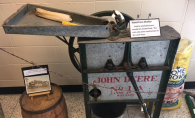The Roaring '20s (pictured above left)
The 1920s were a turning point in women’s hairstyles. Shedding the formal Victorian era and embracing everything from shorter hemlines to cropped hair, the brave women of the 1920s paved the way for bold, androgynous glam looks. Finger waves were typically created by barbers by meticulously molding the hair into tight waves with—you guessed it—their fingers.
“Our modern day interpretation is a molded wave and pin curls that would be perfect for a wedding style or a gala event,” says Heather Klement of Spark Salon.
Today you can see finger waves as an element of many trendy red-carpet styles.
The influence of hairstyles from the past century show up today in the trends seen on celebrities and in magazines as well as in the local coffee shop or at high school prom. Area hair experts at Spark Salon and 18/8 Fine Men’s Salon team up to bring us men’s and women’s looks, and some understanding of the decade that inspired the styles. You’ll never again look at today’s hip ’dos without noting echoes of the past.
Vintage '30s (pictured above right)
Hair for men in this era was short with a bit of length on top and shorter backs and sides. A generous amount of hair cream or oil was used and hair was combed back, often with an offside part. Men also sported pencil mustaches or big, curled styles that required mustache wax.
Our model’s hair is cut short around the hairline and gets gradually longer into a masculine box shape. Hair on top can be shorter to add a sporty look, with length in front left to sweep back, keeping with the vintage look.
“With Justin’s finer and lighter textured hair, we use a matte finish product when styling,” says Paula Ennen of 18/8 Salon. “His beard is shaped into a strong, square shape, keeping in line with more mainstream hair today and the hipster trend,” she adds.
Hollywood Glam '40s
With the invention of the hair dryer, hair took on a huge shift. In the midst of war rations, items such as bobby pins became scarce and working women needed a method to keep their hair out of their face, thus the victory roll was born. The iconic roll was originally created using pipe cleaners, and proved ideal for women wanting to look feminine without splurging on a perm to keep their hair curled.
Styles became elegant and classic. Our inspiration pulls a victory roll into a contemporary look. “To make it more modern, we incorporated the length of the style into a glam Hollywood wave creating a beautiful look for a date night, out or in,” says Heather Klement at Spark Salon.

(Nichole Goergen, clinical manager RN-BSN and captain in the military)
Rockabilly '50s
The 1950s is considered the era of revolution in men’s hair and fashion. During the beginning of the decade, tapered sides and back with a side part was considered the clean-cut look preferred by parents, schools and the workplace. Soon to emerge was the duck tail and the pompadour. The pompadour had risen to popularity again by 2013 and can be seen today, usually with very short sides and back with a shaved-in part.

(Brian Rinde, national sales manager for Cumberland Products)
Bouffant '60s (pictured below left)
The 1960s styles were inspired by none other than actress Brigitte Bardot. In the ’60s, hair became taller—the taller the better—and bouffants and “beehives” were all the rage. It was a good decade to buy stock in hairspray.
“We love the sexy, tousled look, so to modernize the style the height was lowered a little, but we kept the wispiness of the layers that give movement to the style,” says Laura Haven, stylist at Spark Salon.
You can swipe on a classic red lip and channel Ms. Bardot’s “I-woke-up-like-this” vibe.

(Left: Jill Bailey, Realtor at ReMax; Right: Jack Lunt, student in marketing at the University of Minnesota)
Nostalgia '70s (pictured above right)
The 1970s generally featured longer hair on men, as a way of rebelling against conservative norms. But to fit in to the conservative workplace, styling products geared toward men emerged.
By the end of the decade you could see the shag, the spiked, the Afro, the surfer look and the mullet. Facial hair also became acceptable, seen in sideburns and the thick mustache.
“Today these styles translate into longer hair that can be more casual and free falling on the weekends but also shaped, using strong gels and clays, for the work day,” says Paula Ennen of 8/8 Salon.
Credits
Spark Salon stylists:
Heather Klement, Nick Kort, Jaclyn Blumenberg, Sarah (Chloe) Gustafson, Kayla Vanderziel, Dani Moodie
18/8 Fine Men’s Salon stylists:
Paula Ennen, Katie Andreen, Stephanie Strand
The Hair District makeup artist:
Rachael Notsch









